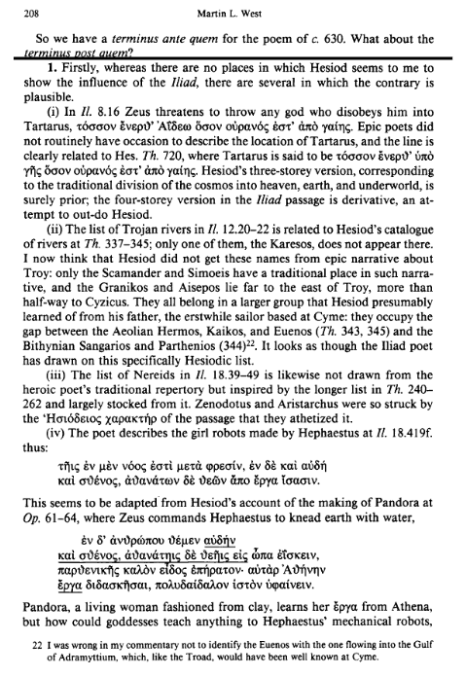- An 8th century date is still very often reported, even in scholarly sources, but generally only by people who aren’t actually making an argument for the date. When you see arguments, the dates are normally 7th century. 8th century datings are a scholarly habit, not a product of scholarship. Barbara Graziosi has put it very memorably (Inventing Homer, 2002, p. 91):
- the eighth-century date is more often stated than argued for.
- Martin West calls the persistence of 8th century datings of Homer a result of ‘dogmatic drag’ (Making of the Iliad, 2011, p. 16): Having been accustomed for generations to think of the formative period of epic as lying two or three centuries before the emergence of the lyric and elegiac poets, scholars continued, when they found themselves compelled to narrow the gap, to cling to the highest date for the Homeric poems that still seemed allowable. The middle of the eighth century became a favourite dating; possibly a little after 750, but certainly not as late as 700. The Iliad still had to be the best part of a century older than Archilochus.
- and then he goes on to dismantle it. West’s own arguments for a dating in the 600s are based on the following points:
- (1) Pictorial depictions of Trojan War scenes appear from about 700 onwards, but depictions of scenes specifically in the Iliad only start to appear in the late 600s. (This is a valid point, but not as simple as West would like.)
- (2) Literary allusions only start to appear in Mimnermus and Alcaeus, from the late 600s onwards.
- (3) Some passages seem to show knowledge of the Hesiodic poems.
- (4) Some passages seem to show knowledge of the kind of martial elegy that we see in Callinus and Tyrtaeus.
- (5) Multiple passages in the Iliad take for granted general knowledge of Egypt, and Greek colonisation in the Black Sea.
- (6) In particular, a passage about the wealth of Egyptian Thebes (Waset/Luxor) is likely to reflect that city’s status in the 25th Dynasty, 715-663 BCE. But the wealth of Thebes may have only came to international attention after the city was sacked by Ashurbanipal in 663. (This is compelling in itself, but the argument only applies to a single passage — and if we’re allowing for interpolations, we have to allow for the possibility that that passage is an interpolation.)
- (7) One passage seems to indicate awareness of steppe pastoralists in Ukraine, again pointing to Greek exploration of the Black Sea.
- (8) The design of Achilles’ shield in book 18 has its closest parallels in Cypro-Phoenician dishes and bowls of the period 710-675 BCE. (A valid point, but not all that compelling by itself.)
- (9) Athena’s aegis and Agamemnon’s shield feature Gorgons, and external evidence for use of this device first appears around 670 BCE.
- Point 9 is by far his strongest argument — and a much stronger form of the same point appears in a 1994 article by Hans van Wees, ‘The Homeric way of war’ (Greece & Rome 41, two parts).
- The strength of point 9 is that the Gorgons appear in several parts of the Iliad. They can’t be dismissed as random one-offs, or as a product of interpolation. Van Wees makes a similar argument for a whole bunch of military equipment and practices — things that are described hundreds of times all over the epic. Van Wees has data: by comparison, West’s points are more like anecdata. Van Wees’s arguments for a post-700 and especially a post-670 dating are based on the Iliadic use of single-grip round shields; bronze greaves; soldiers armed with a single spear; and the overwhelming dominance of spears in death-scenes as the instrument of death. All of these can be tied to transitions in pictorial or material evidence, where the equipment does not appear or only very little prior to 700, but is very common in evidence after 700.
- Martin L. West’s dating: https://www.jstor.org/stable/24819564
